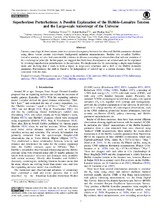| dc.contributor.author | Tiwari, Prabhakar | |
| dc.contributor.author | Kothari, Rahul | |
| dc.contributor.author | Jain, Pankaj | |
| dc.date.accessioned | 2022-02-24T08:23:42Z | |
| dc.date.available | 2022-02-24T08:23:42Z | |
| dc.date.issued | 2022 | |
| dc.identifier.uri | https://doi.org/10.3847/2041-8213/ac447a | |
| dc.identifier.uri | http://hdl.handle.net/10566/7295 | |
| dc.description.abstract | Current cosmological observations point to a serious discrepancy between the observed Hubble parameter obtained
using direct versus cosmic microwave background radiation measurements. Besides this so-called Hubble–
Lemaître tension, we also find considerable evidence in diverse cosmological observables that indicate violation of
the cosmological principle. In this paper, we suggest that both these discrepancies are related and can be explained
by invoking superhorizon perturbations in the universe. We implement this by considering a single superhorizon
mode and showing that it leads to both a dipole in large-scale structures and a shift in the Hubble–Lemaître
parameter. Furthermore, the shift is found to be independent of redshift up to a certain distance. This is nicely
consistent with the data. | en_US |
| dc.language.iso | en | en_US |
| dc.publisher | The American Astronomical Society. | en_US |
| dc.subject | Superhorizon Perturbations | en_US |
| dc.subject | Hubble–Lemaître Tension | en_US |
| dc.subject | Large-scale Anisotropy | en_US |
| dc.subject | Cosmological observations | en_US |
| dc.subject | Dark matter | en_US |
| dc.subject | Hubble-Lemaitre law | en_US |
| dc.title | Superhorizon Perturbations: A Possible Explanation of the Hubble–Lemaître Tension and the Large-scale Anisotropy of the Universe. | en_US |
| dc.type | Article | en_US |

